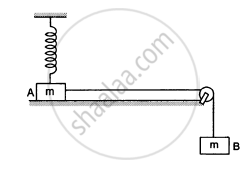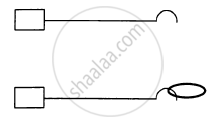Advertisements
Advertisements
प्रश्न
A baloon filled with helium rises against gravity increasing its potential energy. The speed of the baloon also increases as it rises. How do you reconcile this with the law of conservation of mechanical energy? You can neglect viscous drag of air and assume that density of air is constant.
उत्तर
Because the pulling viscous force of the air on the balloon is ignored, there is
Net Buoyant Force = `Vpg`
The volume of air displaced × net density upward × g
= `V(p_(ar) - p_(He)) g(upward)`
Let a be the upward acceleration on the balloon then
`ma = V(p_(ag) - p_(He)) g`
Where m = mass of the balloon
V = Volume of air displacement by balloon
= Volume of balloon
`p_(air)` = density of air
`p_(He)` = density of helium
`m (dv)/(dt) = V * (p_(ar) - p_(He)) g`
`mdv = V * (p_(air) - p_(He)) g * dt`
Integrating both sides `mv = V * (p_(ar) - p_(He)) g t`
`v = V/m (p_(air) - p_(He)) g t`
KE of balloon = `1/2 mv^2`
`1/2 mv^2 = 1/2 m v^2/m^2 (p_(air) - p_(He))^2g^2t^2`
= `V^2/(2m) (p_(air) - p_(He))^2g^2t^2` ......(ii)
If the balloon rises to a height h, from (i)
`a = V/m (p_(ai) - p_(he)) g`
`h = ut + 1/2 at^2 = 0.t + 1/2 [V/m (p_(ai) - p_(Bb))g]t^2`
∴ `h = V/(2m) (p_(ar) - p_(He)) g t^2`
Rearranging the words of (ii) according to h in (ii) and (iii) (iii)
`1/2 mv^2 = {V/(2m) (P_(air) - p_(He)) g t^2} * V(P_(air) - p_(He)) g`
`1/2 mv^2 = {h} * V (p_(air) - p_(He)) g`
`1/2 mv^2 = V * (p_(at) - p_(He)) gh`
`1/2 mv^2 = Vp_(air) gh - Vp_(He) = gh`
`1/2 mv^2 + p_(He)V gh = p_(av) V gh`
`KE_(balloon) + PE_(ballon)` = Change in PE of air.
As a result, as the balloon rises, an equivalent volume of air falls, increasing the balloon's PE and KE at the expense of the air's PE (which come down).
APPEARS IN
संबंधित प्रश्न
A heavy stone is thrown in from a cliff of height h in a given direction. The speed with which it hits the ground
(a) must depend on the speed of projection
(b) must be larger than the speed of projection
(c) must be independent of the speed of projection
(d) may be smaller than the speed of projection.
A block of mass m is attached to two unstretched springs of spring constants k1 and k2 as shown in the following figure. The block is displaced towards the right through a distance x and is released. Find the speed of the block as it passes through the mean position shown.

A small heavy block is attached to the lower end of a light rod of length l which can be rotated about its clamped upper end. What minimum horizontal velocity should the block be given so that it moves in a complete vertical circle?

In the following figure shows two blocks A and B, each of mass of 320 g connected by a light string passing over a smooth light pulley. The horizontal surface on which the block Acan slide is smooth. Block A is attached to a spring of spring constant 40 N/m whose other end is fixed to a support 40 cm above the horizontal surface. Initially, the spring is vertical and unstretched when the system is released to move. Find the velocity of the block A at the instant it breaks off the surface below it. Take g = 10 m/s2.

Figure following shows a light rod of length l rigidly attached to a small heavy block at one end and a hook at the other end. The system is released from rest with the rod in a horizontal position. There is a fixed smooth ring at a depth h below the initial position of the hook and the hook gets into the ring as it reaches there. What should be the minimum value of h so that the block moves in a complete circle about the ring?

A particle is released from height S from the surface of the Earth. At a certain height, its kinetic energy is three times its potential energy. The height from the surface of the earth and the speed of the particle at that instant are respectively ______
A mass of 5 kg is moving along a circular path of radius 1 m. If the mass moves with 300 revolutions per minute, its kinetic energy would be ______.
In a shotput event an athlete throws the shotput of mass 10 kg with an initial speed of 1 ms–1 at 45° from a height 1.5 m above ground. Assuming air resistance to be negligible and acceleration due to gravity to be 10 ms–2, the kinetic energy of the shotput when it just reaches the ground will be ______.
Why is electrical power required at all when the elevator is descending? Why should there be a limit on the number of passengers in this case?
A bob of mass m suspended by a light string of length L is whirled into a vertical circle as shown in figure. What will be the trajectory of the particle if the string is cut at
- Point B?
- Point C?
- Point X?

